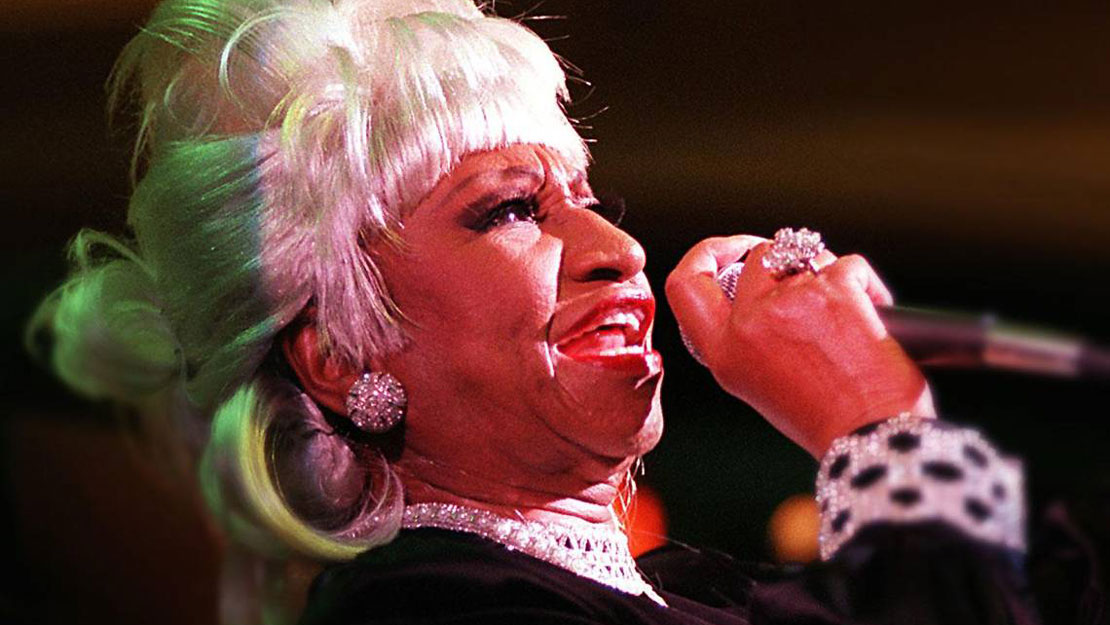By Judy Cantor-Navas / billboard.com – July 16, 2020
Cruz, who passed away 17 years ago today, made history with studio recordings of ceremonial “santero” music.
In the late 1940s, Havana’s Panart Records released an elaborate set of three 78 RPM records under the title Toques de Santo. The recordings feature Alfredo Zayas’ vocal group Coro Yoruba, and Trinidad Torregrosa, Jesus Perez and Virgilio Ramírez, members of the brotherhood of musicians who played the sacred two-headed batá drums.
The lead vocalists on the album are Mercedes Valdés (best known as Merceditas Valdés) and Celia Cruz, two artists, as the liner notes explain, “whose renown as singers at toques [religious rituals] is known in Cuba, in Haiti, in Jamaica and beyond, wherever there is an Afro-creole group dedicated to ancestral ceremonies.”
These recordings — calls to the saints in the Afro-Cuban Lucumí language — are the first known studio recordings by Celia Cruz, the world-renowned “Queen of Salsa” and one of Latin music’s most revered female artists of all time. Cruz passed away 17 years ago Thursday (July 16) in her New Jersey home.
“These recordings marked a milestone for both the career of Celia Cruz and for Cuban music,” says Cuban music writer and researcher Rosa Marquetti, a curator at Gladys Palmera Collection. The collection is located near Madrid, and possesses a rare copy of the set, recorded in 1947, several years before Cruz joined La Sonora Matancera. Cruz’s performances of the salutes to the orishas (Afro-Cuban deities) Changó and Babalú Ayé were first released as a single.
“They are the first recordings by Celia Cruz, and also, as far as we know, this was the first time ever that Afro-Cuban liturgical music was recorded,” Marquetti adds. “These drums were for religious ceremonies — remember that this is just about the second generation after slavery.”
The description of Cruz in the liner notes for the set as a singer in high demand at the ceremonies known as bembés could have been exaggerated by the author for “exotic” effect. But at this early stage of her career, Cruz, already a familiar voice on Cuban radio, was certainly known as a performer of popular Afro-Cuban music.
In 1946, she appeared in “Sinfonía en Blanco y Negro” an Afro-Cuban themed show that Rodney, who would become the celebrated choreographer of the Tropicana’s groundbreaking shows, staged at a Havana theater. As documented by Cuban musicologist Helio Orovio, in the late ’40s, Cruz appeared on a ground-breaking Afro-Cuban music program on Radio Cadena Suaritos, which featured the folkloric group led by Obdulio Morales.
“When I heard those chants and drums for the first time as a young girl I went running to hide,” Cruz had told her biographer Ana Cristina Reymundo, recalling her introduction to Afro-Cuban ritual music as a young girl. “Nevertheless, for me, that music soon became much more than a religion — it became a beautiful way to express my African roots. I learned the Lucumí lyrics to the songs, but I never knew what they meant, although I did learn to pronounce them very well. Years later I realized that those evenings were an important source of inspiration for my music.”
The three 78s in the Toques de Santo set also include recordings of Valdés singing “Ochún” and “Yemayá,” “Obatalá” and “Elegguá.”
“We didn’t play down anything or permit alterations [to the music] of any kind,” Valdés said in an interview quoted by Marquetti on her blog, Desmemoriados, talking about the Suaritos’ Afro-Cuban radio hour. The same is true of the groundbreaking recordings, which feature the sacred chants in their entirety, and for which the Panart studio had to be sanctified before the musicians could perform.
In the late ’30s, anthropologist and ethnomusicologist Fernando Ortiz had begun to unveil the mystery of the rhythms of the Afro-Cuban saints in talks he gave at the University of Havana and other venues that included live batá demonstrations. But in the ’40s, most of the players entrusted with the sacred rites would have refused to play them for the general public because of their holy nature, and also possibly for fear of repercussions that exposing the practices Afro-Cuban culture could incite.
According to Merceditas Valdés, “the enemies of folklore” pressured Radio Suaritos into canceling its program after a year-and-a-half on air, despite its widespread popularity.
“At that time among Afro-Cubans who had managed to have a position in society, there was a lot of silence about the religion because there was a lot of prejudice,” Marquetti says.
It’s possible that Ramón Sabat, the founder of Panart, Cuba’s first full-scale domestic record company, had approached the marketing of the history-making project with some trepidation. Neither Panart catalogues nor advertisements from the period make mention of the Toques de Santo records.
“I think from a commercial point of view, these records had a very limited appeal,” Marquetti explains.
But Panart’s foresight in making the pioneering recordings would later pay off in critical acclaim and commercial returns. In 1957, the label released the tracks together on an LP, titled Santero, that included those previously issued on 78s, as well as new recordings with vocals by Caridad Suarez.
By that time, the sound of Afro-Cuban percussion had deeply penetrated popular Cuban and other Latin music and jazz. Celia Cruz discographies that list her 1950s albums on Seeco, her famous Fania recordings and later global hits make no mention of the existence of “Changó” and “Babalú Ayé.”
Cruz herself didn’t talk about them when she referred to her early years. “It could be that she did not realize how important it was,” says Marquetti. “None of them knew that they were doing something so transcendent for Cuban’s musical culture.”




